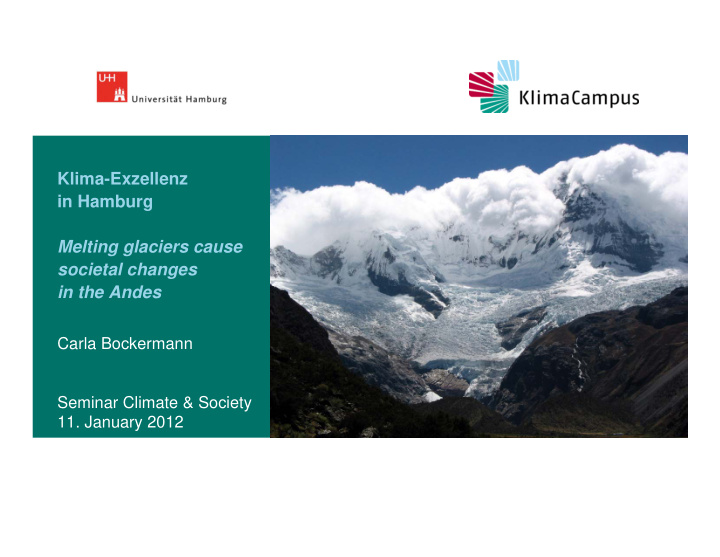



Klima-Exzellenz in Hamburg Titelmasterformat durch Klicken bearbeiten Melting glaciers cause societal changes in the Andes Carla Bockermann Seminar Climate & Society 11. January 2012
Overview 1 Region 2 People and lifestyles Titelmasterformat durch Klicken bearbeiten 3 Tropical glaciers in the Andes 4 Conflict potential 5 General issues 6 Conflict constellations: water-food nexus 7 Adaptation and responses 8 Summary 9 Discussion
1 Region : Andean highlands • Worlds longest continental mountain range (7000 km), • Venezuela, Columbia, Ecuador, Peru, Bolivia, Chile, Argentina • Avg height 4000 m, max 6960 m (Mt. Aconcagua) • Great climate variation (location, altitude, proximity to the sea) • southern Andes rainy and cool, central Andes dry, northern Andes rainy and warm • 40 million people
Altitudinal belts of the tropical Andes Snow, ice, debris T < 10°C Small shrubs, herbs Tropical cloud forest Tropical mountain forest (Source: Diercke Tropical rainforest International Atlas 2010, adapted)
Grazing in the tierra helada and agriculture at 400m
2 People and lifestyles • Vertical lifestyles, subsistance farming & herding • Large farming populations, great diversity of crops in the highlands • greatest crop production in valleys and lowlands • Bolivia: 1/3 of population are farmers, 15% GDP • Peru: agriculture in dry regions is runoff dependent; fresh water is poorly distributed (> 98% on eastern slope) • Altoplano (Peru/Bolivia): 700 communities; 65% of population lives in poverty; very high biodiversity; small scale production; seed banks • Páramo: intensive cattle grazing, plantation cultivation -> severe alteration of hydrological regime
3 Tropical glacier in the Andes 70 % of global tropical glaciers in the Andes 2,940 km 2 (1970) declined to 2,493 km 2 (2002)
Tropical glaciers – ecosystem services • store precipitation/snow and release as water • impact runoff levels & regional water budget • drinikng water (supply 30-40% in Quito, La Paz & El Alto) • irrigation • hydroelectricity (50% in Ecuador, 80% in Perú, 82% in Colombia) • ecosystem integraty
Glacier retreat in the Peruvian Andes average warming of 0.09–0.15 °C decade -1 Thompson et al. 2006
4 Conflict potential Water runoffs with and without glacier contribution and water demand Source: Vuille 2006
World map of environmental conflicts (1980–2005): Causes and intensity
Climate Change prompts cultural shift in Andes People live close to the land Agricultural cycle is marked by religious rituals People dont understand why snow melts, rain comes out of seasons, natural signs are no longer reliabe Microclimates change Changing climate threatens harvest and way of life Crop variety is the people's only insurance against a bad harvest and for resilience As temperatures rise, some high altitude varieties may disappear Glaciers vanish (glacial retreat) -> boggy, high altitude pastures may dry up increasing herders' competition Changing climate may result in forced migration to cities In planning for adaptation to climate change policy makers must listen to farmers needs and fears Potential to loose livelyhoods and traditional way of life
5 Issues • Impacts on subsistence agriculture and rural livelihoods • Changes in local hydrology and ecology reduce biodiversity and productivity of highland agricultural lands changes in water flows • Upward permafrost shift ecosystems change; biodiversity loss; land use competition • Forced rural migration increases El Alto (Bolivia) 20,000 to 900,000 in 30 years
6 Conflict constellations: water-food nexus 1 Small farmers vs. Large landowners 2 Communities vs. Oil industry 3 Mountain communities vs. Government 4 Llama herders (mountains) vs. Big agrobusinesses (coast) 5 Farmers vs. Mining industry
7 Adaptation and responses Small-scale • storage tanks (pilot projects in Bolivia, World Bank funding) • dams and reservoirs • rebuild municipal water systems • efficient drip-irrigation technology (Oxfam project) • Fog catchers (community-level) Technology • Improving crop yield by – Biotechnology or – large native variety pool • Facilitating farmer innovation, building local institutions, and promoting different types of participation
Regional / national level Policies/Programs • National Glacier Policy (Chile): inventories of cryospheric water resources & protection against the impacts of mining on glaciers • National Agua para Todos Rural (water for everyone) program, Peru • Regional Adaptation to Glacier Retreat project (World Bank 2008): adaptation measures in Bolivia, Ecuador, and Peru; glacier monitoring • Andean Agriculture Project for Altiplano: crop diversity, organic agriculture, UN development goals
8 Summary • Glacier retreat in the Andes – burden on native communities and on developing economies who are already struggling • Highest impact of climate change is likely to be on agriculture (reduced diversity and resilience) • Challenges: - planning, modeling, and development process adequate for the changing mountain environments - Climate change is forcing a cultural change - Old elites and power regimes still hold up change and colaboration • Opportunities: - Community-based sustainable development - Bodiversity, Plant species variety (seed banks) as future crops
Titelmasterformat durch Klicken bearbeiten 14.01.2012 Thank you!
9 Discussion Who has the most potential to have a positive impact on this situation?
Recommend
More recommend